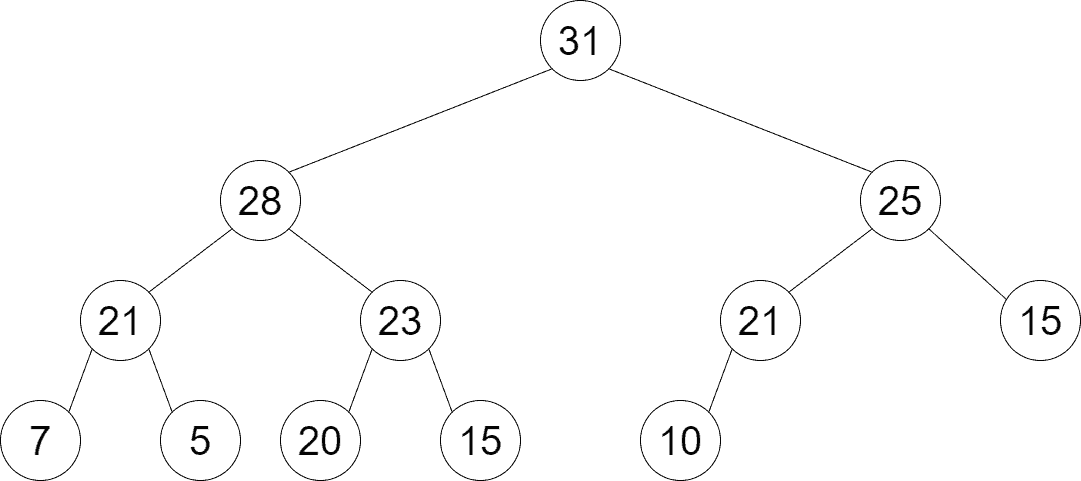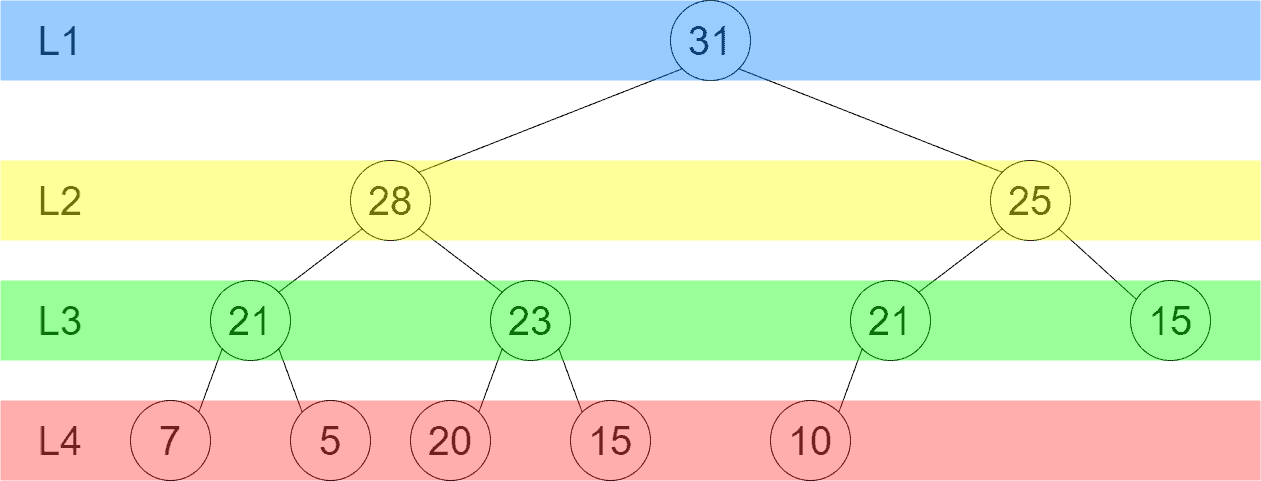1. 简介
在本篇文章中,我们将介绍如何使用数组来表示最大堆(Max Heap)这种数据结构。相比使用显式的二叉树结构,数组实现更加简洁,是实际开发中常用的方式。
最大堆是一种基于完全二叉树的结构,其核心特性是:每个节点的值都不小于其子节点的值。因此,堆顶元素一定是整个堆中的最大值。
2. 数组表示法概览
使用数组表示最大堆时,主要依赖以下两个元素:
elements[]:用于存储堆中所有节点的值tail:记录堆中最后一个元素的索引。若tail == 0,表示堆为空
我们假设数组是从 1 开始索引的,也就是说:
- 堆顶元素位于
elements[1] - 对于任意节点
i:- 左子节点位于
elements[2 * i] - 右子节点位于
elements[2 * i + 1]
- 左子节点位于
- 相应地,任意节点
i的父节点位于elements[i / 2](向下取整)
示例
下图是一个最大堆的二叉树表示:

我们可以按层序遍历顺序将节点填入数组中:

最终数组表示如下:

可以看出,数组中的元素是按照从上到下、从左到右的顺序填入的。
3. 最大堆的操作与伪代码
最大堆支持以下核心操作:
- 插入元素(Insert)
- 获取最大值(Max)
- 移除最大值(Remove Max)
- 构建堆(Heapify)
3.1 插入操作
插入操作将新元素放在数组末尾,然后不断与其父节点比较,若大于父节点则交换,直到堆性质恢复为止。这个过程也称为“上浮”(Heapify Up)。
algorithm INSERT(H, value):
// INPUT
// H = a max heap
// value = the value to insert into H
// OUTPUT
// value is added to H, maintaining the max heap property
H.tail <- H.tail + 1
H.elements[H.tail] <- value
child <- H.tail
parent <- child / 2
while parent >= 1 and H.elements[parent] < H.elements[child]:
SWAP(H.elements[parent], H.elements[child])
child <- parent
parent <- child / 2
✅ 插入时间复杂度为 O(log n)
3.2 获取最大值
最大值始终位于数组的第一个元素(即 elements[1]),因此获取最大值的时间复杂度为 O(1)。
algorithm MAX(H):
// INPUT
// H = a max heap
// OUTPUT
// Returns the maximal element of H
if H.tail = 0:
return null
return H.elements[1]
3.3 移除最大值
移除堆顶元素后,将数组最后一个元素移动到堆顶,然后不断与较大的子节点交换,直到堆性质恢复。这个过程也称为“下沉”(Heapify Down)。
algorithm REMOVE(H):
// INPUT
// H = a max heap
// OUTPUT
// The maximum element of H is removed
if H.tail = 0:
return
H.elements[1] <- H.elements[H.tail]
H.tail <- H.tail - 1
parent <- 1
maxChild <- index of parents maximum child or infinity if it has no children
while maxChild <= H.tail and H.elements[parent] < H.elements[maxChild]:
SWAP(H.elements[parent], H.elements[maxChild])
parent <- maxChild
maxChild <- index of parents maximum child or infinity if it has no children
✅ 删除操作时间复杂度为 O(log n)
3.4 构建堆(Heapify)
Heapify 是从数组构建最大堆的过程。它从中间节点开始,逐个向左处理,确保每个子树都满足最大堆性质。
algorithm HEAPIFY(A):
// INPUT
// A = an array to heapify
// OUTPUT
// A max heap H corresponding to array A
start <- A.size / 2
for i <- start, start - 1, ..., 1:
parent <- i
maxChild <- index of the maximum child of i or infinity if it has no children
while maxChild <= A.size and A[parent] < A[maxChild]:
SWAP(A[parent], A[maxChild])
parent <- maxChild
maxChild <- index of the maximum child of i
or infinity if it has no children
H <- an empty heap
H.elements <- A
H.tail <- H.elements.size
return H
⚠️ Heapify 的时间复杂度为 O(n),而不是 O(n log n),因为叶子节点不需要下沉
4. 小结
本文我们介绍了最大堆在数组中的表示方法,以及如何通过数组实现最大堆的插入、删除、获取最大值和构建堆等操作。
数组实现方式简洁高效,非常适合用于实现优先队列等场景。掌握最大堆的数组实现原理,有助于我们更深入地理解堆排序、Top K 问题等经典算法与数据结构问题。